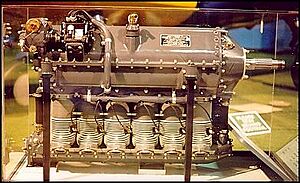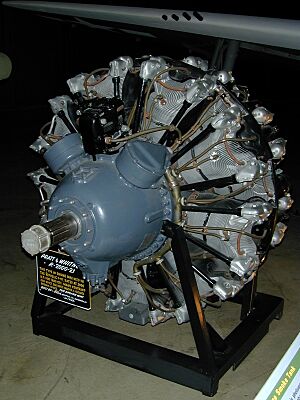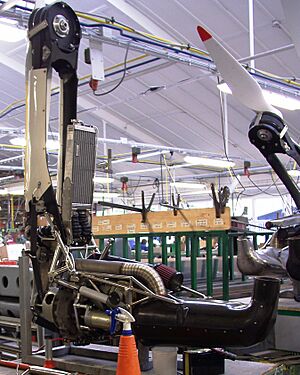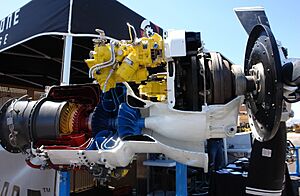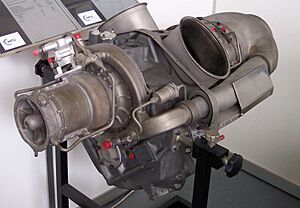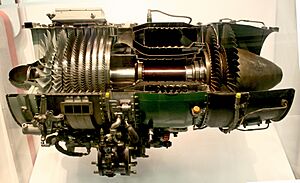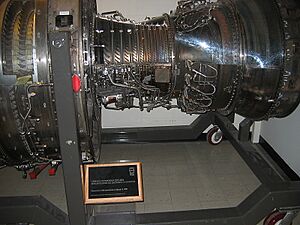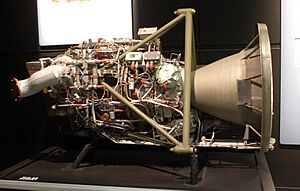Aircraft engine facts for kids
An aircraft engine (also called an aero engine) is like the heart of an aircraft. It's the powerful part that makes planes fly! When an aircraft uses an engine, we call it powered flight. Most aircraft engines are either piston engines (like in cars) or gas turbines (like jet engines). Some aircraft have even used rocket engines, and many small UAVs (drones) now use electric motors.
Contents
Who Makes Aircraft Engines?
Big companies around the world make these powerful engines. For large turbofan engines used in passenger planes, some major companies are Pratt & Whitney, General Electric, Rolls-Royce, and CFM International. In Russia, there's the United Engine Corporation, and in China, the Aeroengine Corporation of China.
For smaller planes that use turboprop engines, Pratt & Whitney is a leading maker.
How Aircraft Engines Developed
Engines have come a long way since the first flights! Here are some important steps in their history:
- 1848: John Stringfellow built a steam engine for a model plane. This was the first powered flight, even if it was just a model!
- 1903: Charlie Taylor built a special engine for the Wright Flyer. This plane made the first controlled powered flight.
- 1908: Louis Seguin designed the Gnome Omega. This was the first rotary engine made in large numbers.
- 1930: Frank Whittle got the first patent for a turbojet engine. This was a huge step for jet travel!
- June 1939: The Heinkel He 176 became the first successful plane to fly only with a liquid-fueled rocket engine.
- August 1939: The German Heinkel He 178 was the first plane to fly using a turbojet engine.
- 1944: The Messerschmitt Me 163B Komet was the first rocket-powered fighter plane used in battle.
- 1945: The first plane powered by a turboprop engine flew. It was a modified Gloster Meteor.
- 1947: The Bell X-1 rocket plane broke the sound barrier!
- 1950: The Rolls-Royce Conway was the world's first production turbofan engine.
- 2020: The Pipistrel E-811 was the first electric aircraft engine to get a special certificate for use in planes.
Engines with Rotating Shafts
These engines use a spinning shaft to create power.
Piston Engines
Piston engines are similar to car engines. They use pistons moving up and down to turn a crankshaft.
Inline Engines
An inline engine has its cylinders in a single row. This design helps planes be sleek and reduce drag. If the engine is mounted upside down, it's called an inverted inline engine. This allows the propeller to be higher, giving more ground clearance.
A downside is that these engines can be heavy for the power they make. Also, it's hard to cool all the cylinders evenly with just air. So, they often use liquid cooling. Inline engines were common in early planes, like the Wright Flyer. But they are rare in modern aviation today.
V-type Engines
In a V-type engine, the cylinders are in two rows, forming a "V" shape. These engines are usually liquid-cooled. The V-design gives more power for its weight than a straight inline engine. It also keeps the front of the engine small.
A very famous V-type engine is the Rolls-Royce Merlin. This powerful V12 engine was used in planes like the Supermarine Spitfire. These planes were very important in the Battle of Britain.
Horizontally Opposed Engines
A horizontally opposed engine (also called a flat or boxer engine) has two rows of cylinders. They are on opposite sides of a central part called the crankcase. These engines are usually air-cooled. They are mounted with the crankshaft flat in airplanes. But they can be vertical in helicopters.
Because of how the cylinders are arranged, these engines run very smoothly. They also have a good power-to-weight ratio. This is because their main body is small and light. Their compact shape helps reduce air drag. These engines always have an even number of cylinders.
Flat, air-cooled engines with four or six cylinders are the most common in small general aviation planes. These are planes that need up to 400 horsepower per engine.
Radial Engines
A radial engine has one or more rows of cylinders arranged in a circle. They are around a central crankcase. Each row usually has an odd number of cylinders for smooth running. Radial engines have a good power-to-weight ratio. This is because they have only one main crankshaft part per row.
These engines cool evenly because many parts are exposed to the air. They also run smoothly. However, oil can collect in the lower cylinders when the engine is off. This oil must be cleared before starting to prevent damage.
In military planes, the large front area of a radial engine could act as extra armor for the pilot. Also, air-cooled engines are less likely to be damaged in battle. They could even keep running if a cylinder was shot! But their large front area also created more air drag.
Rotary Engines
Rotary engines have cylinders in a circle, like radial engines. But in a rotary engine, the crankshaft stays still. The whole engine, including the cylinders and crankcase, spins with the propeller! This design helped keep the engine cool even at slow speeds.
The Gnome Omega was the first practical rotary engine. It flew in 1909. These engines were reliable and powerful for their weight. They helped planes fly faster and further before World War I.
However, the spinning engine created a strong gyroscopic effect. This made planes harder to control. Also, they used a lot of oil, which was mixed with the fuel and burned away. Pilots often felt sick from the fumes! As other engine types improved, rotary engines were used less and less.
Wankel Engines
The Wankel engine is a special type of rotary engine. It's about half the weight and size of a regular piston engine with the same power. It's also much simpler. This makes it a good choice for aircraft, where being light is very important.
Wankel engines don't seize up if they get too hot. This is because they are made of aluminum and steel, which expand differently. This is a great safety feature for planes. After World War II, people thought jet engines would power all planes. So, Wankel engines weren't used much in aircraft. But they were popular in Mazda sports cars.
Today, Wankel engines are sometimes used in motor gliders. Their small size, light weight, and smooth operation are very useful there. Some people even use Wankel engines from cars in their homemade experimental planes. These can be much cheaper than traditional aircraft engines.
Diesel Engines
The most common aircraft piston engines use gasoline. But some attempts have been made to use diesel engines. Diesel engines are usually more reliable. They are also better for long flights at steady power.
In the 1930s, diesel engines were heavy for the power they made. But modern diesel technology has improved a lot. Diesel fuel is also often cheaper than aviation gasoline. This has led to new interest in using diesel engines for small planes.
Power Turbines
These engines use a turbine to spin a shaft, which then powers a propeller or helicopter rotor.
Turboprop Engines
While military planes need to fly very fast, many passenger planes don't. But plane designers still wanted the high power and low maintenance of a gas turbine engine. So, they combined a turbine engine with a traditional propeller.
Turboprop engines spin very fast, so they use a gearbox to slow down the propeller. This stops the propeller tips from going faster than the speed of sound. Turboprops are very efficient when flying at speeds between 200 and 400 mph.
Turboshaft Engines
Turboshaft engines are mainly used for helicopters. They are similar to turboprops. But in a turboshaft engine, the engine doesn't directly hold the helicopter's rotors. Instead, the engine drives a gearbox, and the gearbox is connected to the rotors. Some companies even make both turboprop and turboshaft engines from the same basic design.
Electric Power
Since the 1960s, many electrically powered aircraft have been designed. Some are used as military drones. In 2007, a light plane in France flew over 50 km using an electric motor and batteries. It was the first electric plane to get a special airworthiness certificate.
In 2020, the Pipistrel E-811 was the first electric aircraft engine to get a special certificate for general aviation. It powers the Pipistrel Velis Electro, which is the first fully electric certified airplane.
Small multicopter drones almost always use electric motors.
Jet Engines
Jet engines create thrust by shooting hot gases out the back at high speed. This pushes the aircraft forward, following Newton's laws. The most common jet engines are turbojets and turbofans. Other types like ramjets and rocket engines also exist. Jet engines get oxygen from the air to burn fuel. Rockets carry their own oxygen, so they can work in space.
Jet Turbines
Turbojet Engines
A turbojet is the simplest type of jet engine. It was first made for military fighter planes during World War II. It has a compressor to suck in and squeeze air. Then, fuel is added and burned in a combustion section. Turbines use the hot gases to power the compressor. Finally, a nozzle shoots the hot gases out the back to create thrust.
When turbojets first came out, fighter planes with them were much faster than piston-powered planes. But turbojets have some downsides. Below about Mach 2 (twice the speed of sound), they use a lot of fuel and are very noisy. Early designs also reacted slowly to power changes. This caused problems for many pilots. Because of these issues, pure turbojets are rarely made today. The Concorde airliner was one of the last planes to use turbojets. Its Mach 2 speed made the engines very efficient.
Turbofan Engines
A turbofan engine is similar to a turbojet. But it has a large fan at the front. This fan creates thrust much like a propeller inside a tube. This makes the engine much more fuel-efficient. The fan is surrounded by a duct, which helps it work better than a regular propeller. Turbofans are more efficient than propellers at high speeds. They can even fly at supersonic speeds.
Turbofans usually have extra turbine parts to spin the fan. They were also among the first engines to use multiple spools. These are spinning shafts inside each other that can turn at different speeds. This helps the engine react faster to changes in power.
Turbofans are divided into low-bypass and high-bypass types. Bypass air goes through the fan but around the main engine core. It doesn't mix with fuel and burn. The ratio of this bypass air to the air going through the core is called the bypass ratio. Low-bypass engines are used for military planes because they give a lot of thrust for their weight. High-bypass engines are better for passenger planes because they use less fuel and are quieter. High-bypass turbofans are usually most efficient when planes fly around 500 to 550 mph.
Advanced Technology Engines
This term refers to the newest jet engines. The idea is that an engine works best if its different turbine parts can spin at their own perfect speeds. A true advanced engine has three main spinning shafts (a "triple spool"). This lets three sets of blades spin at different speeds. Some engines have two shafts (a "twin-spool" engine), allowing two different speeds.
Pulsejet Engines
Pulsejets are simple engines with no moving parts. They suck air in through a valve, burn fuel, and then shoot hot gases out the back. This creates thrust in quick bursts, like pulses. The most famous use of this engine was in the German V1 flying bomb during World War II. These engines were extremely loud. They caused so much damage to the plane itself that they weren't practical for manned aircraft.
Rocket Engines
A few aircraft have used rocket engines for main power or to control their direction. Famous examples include the Bell X-1 and North American X-15.
Rocket engines are not used for most aircraft because they use a lot of fuel very quickly. But they are useful for short bursts of speed or for taking off. When fuel efficiency isn't the main concern, rocket engines are great because they make a lot of thrust and are very light.
Rocket Turbine Engines
A rocket turbine engine combines a liquid-propellant rocket with a turbine jet engine. It has a slightly higher power-to-weight ratio than a regular jet engine. It also works well at higher altitudes.
How Engines are Numbered
On planes with more than one engine, the engines are numbered from left to right when you're sitting in the pilot's seat looking forward. For example, on a four-engine plane like the Boeing 747, engine No. 1 is on the far left wing. Engine No. 3 is on the right wing, closer to the plane's body.
On the English Electric Lightning, which has two jet engines stacked one above the other, engine No. 1 is below and in front of engine No. 2.
For the Cessna 337 Skymaster, which has one engine at the front and one at the back, engine No. 1 is the front one. Engine No. 2 is at the back.
What Fuel Do Engines Use?
Piston engines in aircraft usually run on aviation gasoline. Avgas has a higher octane rating than car gasoline. This allows engines to make more power and be more efficient at higher altitudes. The most common Avgas today is 100LL. The "100" means its octane rating, and "LL" means "low lead."
Avgas is made with tetraethyllead (TEL) to get its high octane. But governments no longer allow TEL in car gasoline. Because TEL supplies are shrinking and environmental rules are getting stricter, finding new fuels for general aviation planes is very important.
Turbine engines and aircraft diesel engines use different types of jet fuel. Jet fuel is a type of kerosene that is less likely to catch fire easily. It also has special additives and must meet strict aviation safety rules.
Model aircraft often use special "glow engines" that run on a mix of methanol, nitromethane, and lubricant. Electric model planes and helicopters are also very popular. Small multicopter drones are almost always electric.
See Also
- Aviation safety
- Engine configuration
- Federal Aviation Regulations
- Hyper engine
- Model engine
- United States military aircraft engine designations




